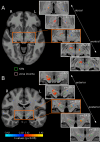Lateralized Subthalamic Stimulation for Axial Dysfunction in Parkinson's Disease: Exploratory Outcomes and Open-Label Extension
- PMID: 39136363
- PMCID: PMC11542286
- DOI: 10.1002/mdc3.14188
Lateralized Subthalamic Stimulation for Axial Dysfunction in Parkinson's Disease: Exploratory Outcomes and Open-Label Extension
Abstract
Background: A randomized trial suggested that reducing left-sided subthalamic stimulation amplitude could improve axial dysfunction.
Objectives: To explore open-label tolerability and associations between trial outcomes and asymmetry data.
Methods: We collected adverse events in trial participants treated with open-label lateralized settings for ≥3 months. We explored associations between trial outcomes, location of stimulation and motor asymmetry.
Results: 14/17 participants tolerated unilateral amplitude reduction (left-sided = 10, right-sided = 4). Two hundred eighty-four left-sided and 1113 right-sided stimulated voxels were associated with faster gait velocity, 81 left-sided and 22 right-sided stimulated voxels were associated with slower gait velocity. Amplitude reduction contralateral to shorter step length was associated with 2.4-point reduction in axial MDS-UPDRS. Reduction contralateral to longer step length was associated with 10-point increase in MDS-UPDRS.
Conclusions: Left-sided amplitude reduction is potentially more tolerable than right-sided amplitude reduction. Right-sided more than left-sided stimulation could be associated with faster gait velocity. Shortened step length might reflect contralateral overstimulation.
Keywords: Parkinson's disease; asymmetry; axial motor function; deep brain stimulation; lateralization.
© 2024 The Author(s). Movement Disorders Clinical Practice published by Wiley Periodicals LLC on behalf of International Parkinson and Movement Disorder Society.
Figures


References
Publication types
MeSH terms
Grants and funding
- Chair in Neuromodulation at the University of Toronto and University Hospital Network, Toronto, Ontario, Canada
- Banting Fellowship #471913/CAPMC/ CIHR/Canada
- Edmond J. Safra Program in Parkinson's Disease and the Morton and Gloria Shulman Movement Disorders Clinic, Toronto Western Hospital, University Hospital Network, Toronto, Ontario, Canada
- R25 NS088248/NS/NINDS NIH HHS/United States
- R25 NS098999/NS/NINDS NIH HHS/United States
LinkOut - more resources
Full Text Sources
Medical
Research Materials
Miscellaneous

